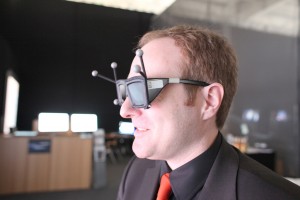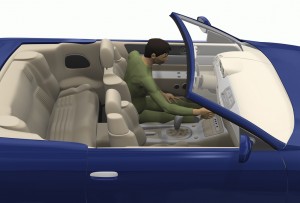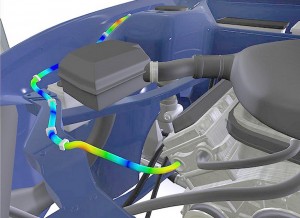
Users of IC.IDO's virtual reality software wear strange glasses with antennae so the system can position them in the computer environment.
It’s users look like they were picked to be some weird bug in the school play.
But the antennae on the strange glasses actually allow the user of IC.IDO’s virtual reality program called Virtual Decision Platform to see the vehicle’s system in 3D.
During a demonstration, the German company’s Gary Brincat explained how the user can wear the special glasses and see an engine, for example, as if they were looking at the real thing. Step to the left side of the screen and you can see the front side of the motor. Step to the back and the view changes, first to the side, then the back of the engine. Kneel down and you can see the underside.
Brincat, vice president of U.S. operations for IC.IDO – say “I see, I do,” said automakers are using the system to see what their designs will look like before they are built. But they also can use the system for training for the assembly line to show the method for installing a part. Conversely, it can be used to determine the difficulty of removing a part, such as an air conditioning compressor, when repairs are needed.
“Can I get the parts in, can I get them out,” Brincat said. With the system, the user can “grab” the part they want and move it around. Because the system knows the shape and size of each part, the user is forced to move parts around pieces that are still in place.
For the cost of one physical prototype, companies can create hundreds of virtual ones, he said.
Some jobs require a smaller person, or maybe someone with smaller hands, to perform the task. VDP can vary the physique of the user to see what size person can do the job.

Virtual Design Platform allows car companies to show multiple versions of a car at a clinic without building expensive prototypes.
Some companies have also used the system in customer clinics to find what potential buyers might like best.
“You can do a lot of customer clinics without building five variations,” he said.
The system looks so real that some people actually act as if it is, Brincat said.
“People set their keys on the console and they drop to the floor,” he said. While looking through the glasses, it would appear that you could reach out and grab a particular part, but when you do, the only thing there is air or the screen if you reach far enough.
IC.IDO has a number of configurations for the system, from desktop computers to power walls to caves where every surface has a virtual reality image. Brincat said the company uses off-the-shelf hardware so if something breaks, it can be replaced easily.
While 3D stereo imaging has been around for many years, IC.DO’s big innovation is the interaction with the image. The antennae tell the computer the position of the user’s eyes within the environment and adjusts the picture accordingly.
Work on the program began 15 years ago at Fraunhofer-Gesellschaft, a German research institute, with funding from Mercedes and was spun off into a for-profit company. The company sold several of the systems during the last 18 months.
Prices start as low as $80,000 for a desktop-size screen but go up to $1 million or more for a cave system.
So is IC.IDO involved in the gaming industry? Brincat said no, but video game makers have helped by driving the cost of hardware down.

